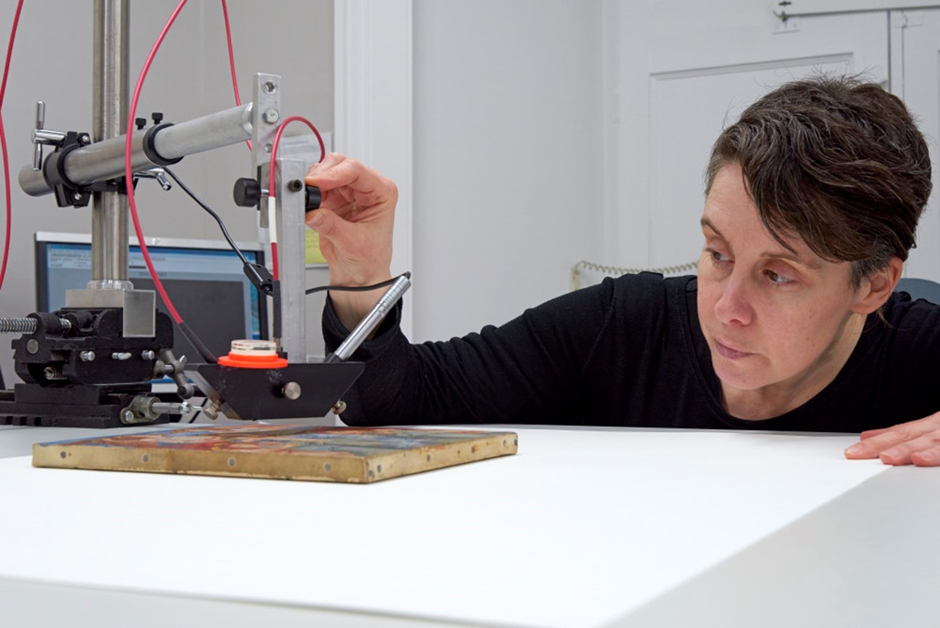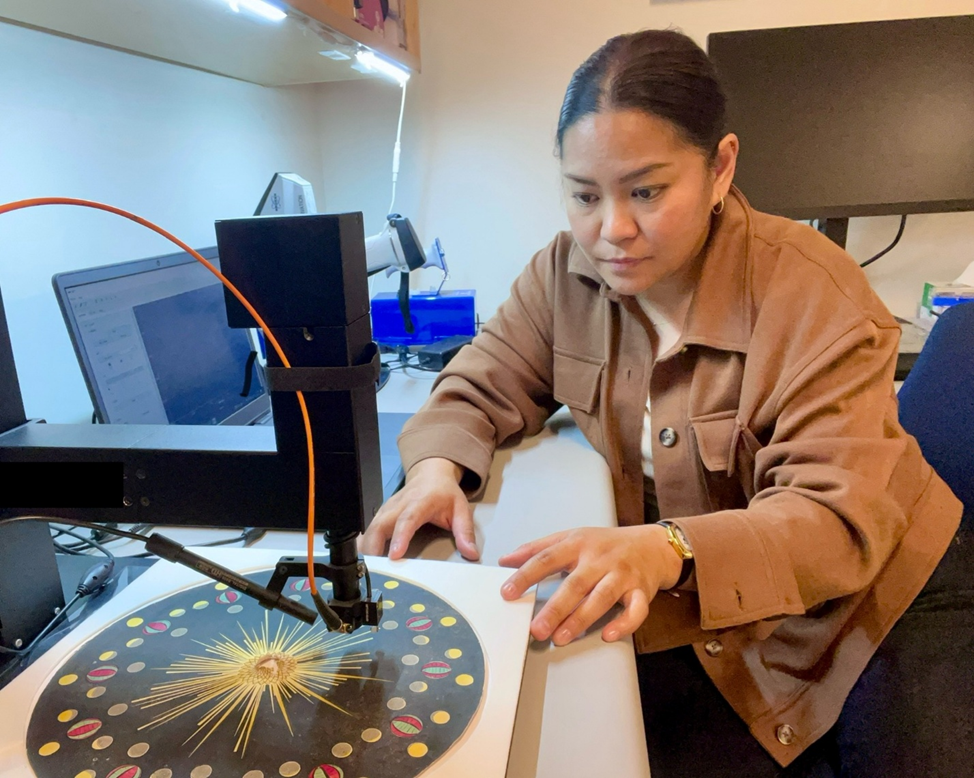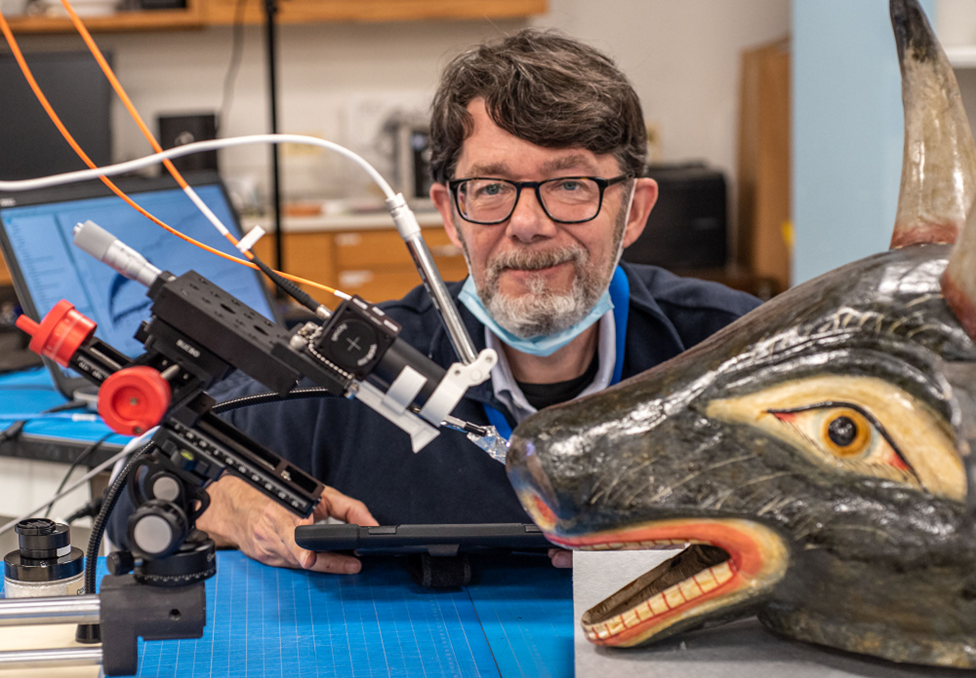Organizing and launching the Microfading Tester International Discussion Group (MFT-IDG) has been the definition of a team effort and we wanted to briefly introduce you to the amazing MFT-IDG officers working behind the scenes.
--------------------
Kirsten Dunne ACR, MFT-IDG Information Repository Officer (Senior Projects Conservator, National Galleries of Scotland)

• How were you introduced to MFT?
I started Microfading in 2012, when we purchased an MFT for our Conservation Department. Our Director of Collections Care Jacqueline Ridge trained as a paintings conservator and, having worked with Dr. Paul Whitmore on the Rothko paintings (which in part instigated the development of the MFT), had wanted an opportunity to get an MFT.
As a piece of equipment that would benefit our collection long term, we were able to purchase an MFT using Heritage Lottery funding for a project to refurbish our Portrait Gallery. With it came Bruce Ford, who spent a month in Edinburgh training me bootcamp style to build, rebuild, and use the MFT and apply it to risk-based collections management, which I have been doing ever since.
• What types of MFT do you use?
I use an ‘original’ Whitmore MFT with a Xenon light source. We are hoping to upgrade to an LED source in the coming year.
• What types of colleagues do you communicate with about MFT?
I work very closely with our conservation department, across all media types, and our curators. We’ve involved curators in the process since the start, and they now often come to me asking for MFT data before they make an exhibition or display list.
Currently, I am working to embed MFT, acceptable lifespan, and risk-based collections management in our conversations and thinking across the organization. This includes working with Publishing, Marketing, and Learning and Engagement colleagues to help them understand how their needs for the collection impact collection access and preservation. I am also working with our Board of Directors to define what ‘acceptable lifespans’ mean and why we might apply the concept to our collection.
• Why did you join the MFT-IDG? What do you want the MFT-IDG to accomplish?
I joined the MFT-IDG to connect with the wider MFT community and help ensure that it includes an international outlook. I would really like to collate, create, and improve information held around MFT so that new and experienced users alike can understand the principles of MFT and how to use and apply it.
• Describe an interesting object tested with MFT.
I have now tested over 1400 objects from our own collection and for external clients. Every object brings its own interest, but often it’s the objects that my external clients bring me that have added layers. These have included a Papal Bull, a purple silk dress dating to the 1830-70’s, hawk moths, and a Coptic sock dating from c. 300-500AD. The sock created a lot of interest from people passing my studio as it was so very different to anything we have in our largely fine art collection.
• What is one piece of advice you'd like to share about MFT practice or the application of MFT data?
Don’t be afraid of the equipment! Understand it, develop a relationship with it, and be willing to accept it as a tool that opens up access to your collections and challenges preconceptions.
--------------------
Rio Lopez, MFT-IDG Secretary (Associate Objects Conservator, Academy Museum of Motion Pictures)

• How were you introduced to MFT?
I was first introduced to MFT in graduate school as an analytical technique that can be utilized to determine an object’s light sensitivity.
• What types of MFT do you use?
At my institution, we use an Instytut Fotonowy Microfade Tester.
• What types of colleagues do you communicate with about MFT?
I share my experience with MFT with colleagues from various departments across the museum field who are interested in the field of conservation. I also often reach out to other conservators and conservation scientists at different institutions about specific topics on MFT.
• Why did you join the MFT-IDG? What do you want the MFT-IDG to accomplish?
I joined the MFT-IDG to gain access to the small community of users who use this equipment. I particularly wanted to learn from the leading professionals on this topic and how they are using the equipment to advance the field of material culture.
• Describe an interesting object tested with MFT.
Our conservation team was able to use the MFT to analyze the light sensitivity of a contemporary costume used in a film that was constructed entirely from faux flowers.
• What is one piece of advice you'd like to share about MFT practice or the application of MFT data?
There is a learning curve in the maintenance of the data and the physical MFT equipment that can be time consuming. This is something I became more aware of when I started working with the instrument.
--------------------
JP Brown, MFT-IDG Vice Chair (Senior Conservator, Field Museum)

• How were you introduced to MFT?
I was aware of MFT from the preventive conservation literature since Paul Whitmore’s article in Studies in Conservation. My interest was brought into focus by a paper by Bruce Ford at the 2017 ICOM-CC triennial. When the opportunity to take a Getty-organized pre-conference workshop at the 2019 AIC Annual Meeting came along, I jumped at it.
• What types of MFT do you use?
At the Field Museum we use a variant of the Jacob Thomas retroreflective head with a four-channel LED light source.
• What types of colleagues do you communicate with about MFT?
Curators, exhibit designers, and community partners.
• Why did you join the MFT-IDG? What do you want the MFT-IDG to accomplish?
MFT can be tricky. There needs to be somewhere where people can reach out for help when they have problems with equipment or unexpected results.
• Describe an interesting object tested with MFT.
I tested the various paints on a Space-X Dragon capsule for long-term display.
• What is one piece of advice you'd like to share about MFT practice or the application of MFT data?
Use dE*2000 or DIN99 for calculating color shift (they’re pretty equivalent). Don’t use dE*94 or dE*76, as they’re not uniform over the whole CIELAB color space.
--------------------
Cindy Connelly Ryan, MFT-IDG Programming Officer (Preservation Science Specialist, Library of Congress)

• How were you introduced to MFT?
I interned in Paul Whitmore’s lab in the early 1990’s, making endless drawdowns of paint samples for fading tests, and remember him loudly wishing that there was a predictive tool like this instead! (And heard the earliest glimmers of his thinking about how one might design one).
Fast forward a decade and change to the early oughts, the Library of Congress Conservation Division ordered the parts to build a Whitmore-designed xenon arc system, which they ultimately handed off to the Research and Testing Division. One of our summer interns tackled putting it together, with a lot of help from Chris Maines over at the National Gallery of Art and encouragement from me and our Chief. After she left…...I figured the rest out, slowly.
• What types of MFT do you use?
That 2007 xenon arc system, with a few upgrades, remains our lab’s workhorse, which we now supplement as appropriate with a Fotonowy LED unit. And we’ve just finished building a retro-reflective head with a multi-LED light engine following JP Brown’s (Field Museum) design that we hope will be the best of both worlds.
• What types of colleagues do you communicate with about MFT?
Most of our collection item testing is done on pieces being evaluated by Conservation for a loan or exhibit, and thus our reports usually go directly to the exhibits conservation team. They combine our findings and recommendations with their own assessments of the piece’s stabilization or other needs, which is communicated with the Interpretive Programs Office and with the Curators involved in the exhibit’s planning.
• Why did you join the MFT-IDG? What do you want the MFT-IDG to accomplish?
MFT is the interesting example of an analytical technique developed within, by, and for the Heritage Conservation community, and as such pretty much every practitioner has learned the ropes with help from other users to one extent or another, whether via direct coaching or just sharing resources and tips.
In essence, I joined to ‘pay it forward’. I hope that the MFT-IDG will foster that spirit of collegial knowledge exchange by linking MFT users to each other beyond our immediate professional circles, and provide newer practitioners opportunities for hands-on experience as well as sources of advice.
• Describe an interesting object tested with MFT.
I had the privilege of testing some amazing pieces during the planning phase for a recently opened gallery, Treasures from the Library of Congress. Some were breathtakingly beautiful, some historically important, and others deeply moving; I’ve written blog posts about three of them, which you can read here and here.
• What is one piece of advice you'd like to share about MFT practice or the application of MFT data?
Remember that MFT is a useful screening tool for informing decision making, but it is not an all-powerful, all-seeing eye. This is an accelerated test method, and thus by nature has some built in uncertainties. It’s not going to capture all the nuances of deterioration and aging that an object will undergo. It only seeks to sort items into “big buckets” of light sensitivity—is it extremely light sensitive, very light sensitive, relatively stable—to place it into the right CIE lighting guideline category.
--------------------
Vincent Laudato Beltran, MFT-IDG Chair (Scientist, Getty Conservation Institute)

• How were you introduced to MFT?
I was introduced to the MFT by Jim Druzik and Christel Pesme as part of the GCI’s Museum Lighting Research project. At that time, they were working with a suite of MFTs described in the paper “Comparison of five microfading tester designs”. (This was included in the postprints for the 2010 Research and Technical Studies session focused on MFT, which I’ve added to the MFT-IDG library.)
• What types of MFT do you use?
We’ve largely relied upon the original Whitmore MFT setup and have recently begun incorporating testing with the Instytut Fotonowy MFT. We also hope to follow in JP’s and Cindy’s footsteps by building a retroreflective MFT. An aspiration of ours is to develop an MFT loans program similar to that of the Canadian Conservation Institute where we bring our unit to other institutions and train their staff to use the MFT for several weeks.
• What types of colleagues do you communicate with about MFT?
Everyone! When the MFT first arrived at the GCI, users were largely limited to the science team, but it soon became apparent that there was broad interest in MFT and we didn’t have enough time to accommodate all the testing requests. So we pivoted and regularly trained anyone interested in the technique, allowing us to build up a community of MFT users.
• Why did you join the MFT-IDG? What do you want the MFT-IDG to accomplish?
After the organization of a 2018 Experts Meeting on MFT, there was an obvious need to organize the global community of MFT users, but we were unsure how to do this. Fast-forward to 2023 when I mentioned MFT as an aside during a conversation with Kelly McCauley, then chair of AIC’s Preventive Care Network; she thankfully picked up on that thread and suggested an MFT listserv with AIC, which evolved into the MFT-IDG.
I hope the MFT-IDG becomes a place where we can both push the boundaries of the technique and support and uplift those interested in learning about MFT.
• Describe an interesting object tested with MFT.
In 2014, I compared the color change for samples of still-green Aster leaves, Dryopteris leaves, and Scirpus grasses exposed in a halogen lightbox and examined with MFT. While they rapidly shifted from green to brown in the lightbox, I was curiously unable to induce any color change with MFT. (This was later corroborated through experiments conducted by Paul Whitmore’s team.) This disparity between the lightbox and MFT results may be due to the biological complexity of these leaves and grasses, providing protection against exposure to a tiny but intense MFT light spot but less so when broadly exposed in a lightbox.
• What is one piece of advice you'd like to share about MFT practice or the application of MFT data?
I’m quite fond of this quote from Bruce Ford about MFT: “Uncertain data is better than none. With data, everything becomes negotiable.”